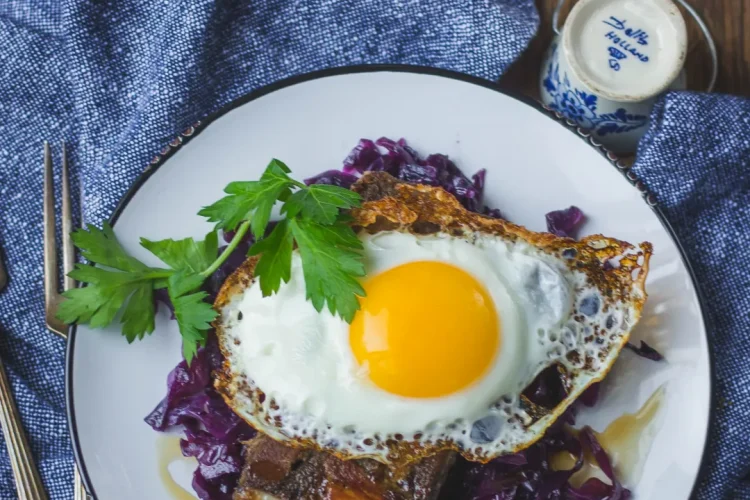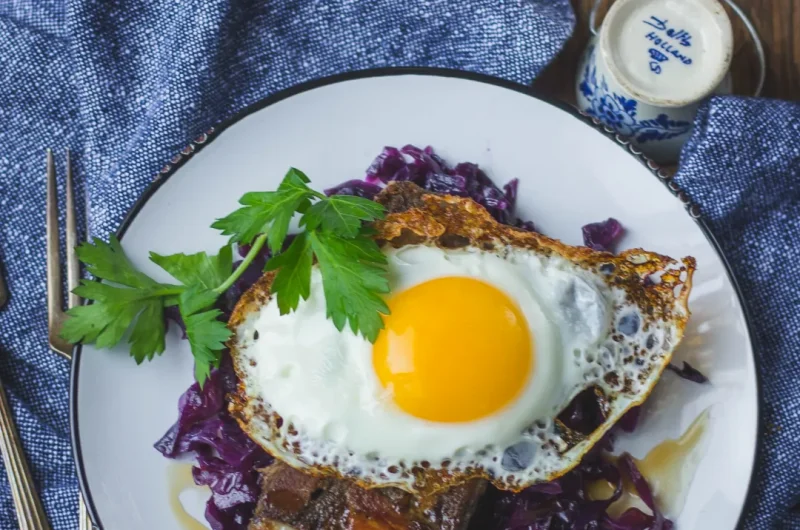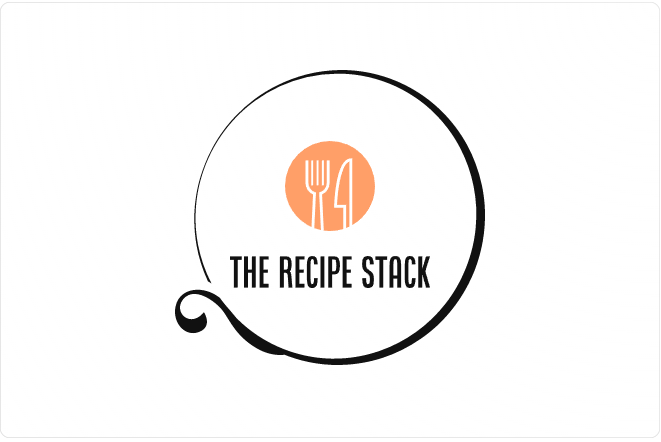This balkenbrij is perfect for breakfast, hearty enough for brunch, and delicious enough to transcend the boundaries of mealtime rules to be served alongside a beer at just about any time, including dinner.
I’m excited about the recipe I’m sharing here: both because it is rare to see Dutch food updated in a more modern context and also because, during my research for this recipe, I found that it has a unique connection to my family! Read on.
What is balkenbrij?
Balkenbrij was typically made from leftover pork parts (especially the head) after butchering a hog as a way to use the scraps so they wouldn’t be wasted. One Dutch writer described it as “a mixture of brains, eyeballs, and other leftover parts of pigs, pressed together with lard to form a loaf. Sliced thin, it could be fried and dished up with corn syrup, presumably to cover its many sins.”
The fat and leftover meats would be boiled, mixed with buckwheat, formed into a loaf, sliced, and then pan-fried to crisp the edges. Buckwheat was added to extend the scraps and make it a hearty, gut-filling meal that would see you through the day. Though the Dutch immigrants made their way to the Americas, the traditional buckwheat was often replaced with cornmeal, making it more akin to another dish that immigrated to the Americas via the Pennsylvania Dutch, Amish, and Mennonite communities – scrapple. It’s also similar in some ways to goetta, which migrated from Germany and found a home in Cincinnati.
It was a dish often eaten for breakfast, the buckwheat and fatty pork laying down a solid base that would stick to your ribs and get you through the day. It was undeniably peasant food, though, the kind of food born out of the necessity and determination to make each scrap count for something. Nothing was wasted: this was original ‘nose to tail’ dining before it was trendy.
How I discovered this recipe?
This specific balkenbrij is inspired by a meal I had in Holland, Michigan, the home of a large population of Dutch immigrants and Dutch descendants that have capitalized on their town’s name to add Dutch traditions to what would be a typical Michigan beach town. Windmills and klopfen (the wooden Dutch shoes) abound. I drove through the area, tracking down the one physical document of my Dutch grandfather’s immigration to Canada that was stored in an archive in the area. After a stop at the library, it was a stop at the brewery (that’s pretty much how I roll).
Looking through the menu at the brewpub, I had never heard of balkenbrij despite growing up in a Dutch family, but I recognized the ‘brij’ from other dishes I’ve made. I asked the bartender about it and rather than trying to describe it, she simply said, “it’s probably our most popular dish; you should definitely try it.” And I was sold. I didn’t know what I was getting myself into.
It was delicious, though, and I couldn’t stop talking about it after I ate it. Dutch food rarely wins any sort of popularity contest and rarely does anyone try to update it. But it was SO GOOD! Perhaps one of the best things I ate on a trip built around eating delicious things. I knew I had to come home and try to make something similar.
While working on the recipe and trying different iterations, I felt I was getting close to a final recipe. Then, I reread some passages from a family history book. The initial phase took me a few tries, both because there were few recipes in English, especially ones that didn’t use pork heads and leftovers, and because I wanted to try and recapture that taste of the one I had in Michigan.
My great uncle on my dad’s side, at one point, had compiled and written a family history of my great grandmother – from her time growing up in Holland through to her immigration to Canada and her life here. It is a meandering, cluttered book meant to chronicle family history and is based on chats with my great grandmother before she died and the diaries she kept. I had gone through it previously and highlighted all the sections that had anything to do with food, thinking that maybe some writing and recipes might come out of it.
There is one (and only one) recipe included in the book, randomly dropped into the middle of a story about her life in Holland. I had obviously highlighted it but hadn’t thought much of it as I didn’t recognize the dish and it looked a little unlikely that I would ever make it: I mean, when was I going to make a dish that used a pig head and cracklings?
Looking back after my trip and my recipe testing, I recognized the recipe for balkenbrij immediately! My great uncle wrote this about my great grandmother and her balkenbrij:
“Butchering was a busy time for Hendrika [my great-grandmother] too. One of her jobs was to clean the pig’s intestines to be used as sausage casings. She made regular meat sausage but also such delicacies as liver sausage, lung sausage, blood sausage, and headcheese. Hendrika also had the gift of making a wonderful delicacy known as balkenbrij. It was something known in the Achterhoek where she was born, but in Drenthe [where she was living at the time after marrying my great-grandfather], it was unknown.”
This tracks with what I knew about balkenbrij that it was a recipe common in the south of Holland but not in the north where my family came from. But my great-grandmother had kept it alive. The recipe that follows is a typical one, though it never specifies the type of flour she used. It also changed my recipe testing, as I wanted to incorporate elements of this recipe to carry on the gift of this ‘wonderful delicacy’! So here’s my recipe, based on the one I ate in Michigan, my great-grandmother’s recipe, and my small tweaks.
What makes this balkenbrij special?
This recipe forgoes the pleasures of the eyeballs and offal and chooses a more premium cut (pork butt) to make a meatier version of the loaf while still ensuring it has the necessary fat that makes it so delicious. Making pulled pork should be familiar to many (it’s a classic American BBQ food), and the extra step of frying the loaf crisps the edges of the tender pork, not unlike pork carnitas. The pork in traditional balkenbrij was typically ground or minced into a more delicate texture, but here I’ve left it in longer, meatier pieces, giving it more texture and making it more like pulled pork.
This recipe also takes the dish beyond the loaf itself. The maple in the braised cabbage adds a sweetness that balances the salty, fatty pork, replacing the more traditional corn syrup (we don’t need to cover the sins of this loaf!). The corn syrup was likely added as Dutch immigrants made their way to places like Michigan, where maple syrup is abundant and they were taught how to harvest it by the indigenous peoples of the area. I’ve added the spices into the loaf, following my great-grandmother’s spicing, but also spiced the cabbage – adding some anise for a unique but traditional Dutch twist. The fried egg on top takes it one step closer to a breakfast dish we might all be familiar with and is pretty much my secret breakfast weapon – add a fried egg to just about any leftovers from the day before and, tada, you’ve got a killer breakfast!
While perhaps pushing your comfort zone in terms of what you’re familiar with, this recipe has all the elements of a classic savory American breakfast. The pulled pork matches the meaty part often provided by bacon or sausage, the buckwheat in the balkenbrij corresponding to the hotcakes. The fried egg is a hallmark of these breakfasts too, and then the plate often has an abundance of sweet maple syrup that spreads over the plate, tying it all together. I, for one, love when my bacon sits in that pool of maple syrup.
This balkenbrij recipe is classic Dutch fare, something my family made in Holland, but it’s also an updated, (North) Americanized version. It’s perfect for breakfast, hearty enough for brunch, and delicious enough to transcend the boundaries of mealtime rules to be served alongside a beer at just about any time, including dinner.
Balkenbrij Recipe
Course: BreakfastCuisine: DutchDifficulty: Medium10
servings20
minutes4
hours30
minutes4
hours50
minutesThis balkenbrij is perfect for breakfast, hearty enough for brunch, and delicious enough to transcend the boundaries of mealtime rules to be served alongside a beer at just about any time, including dinner.
Ingredients
- For the balkenbrij:
4.5-5.5 lb bone-in pork butt roast (end result: 2-2.5 lb pulled pork)
3 tablespoons of vegetable oil
3 onions, peeled and halved
3 bay leaves
6 cloves
1/2 whole nutmeg, finely grated
4 cups of water
3/4 cups of buckwheat flour
salt
- For the braised cabbage:
2 tablespoons of bacon fat, or butter
1 onion, finely sliced
1 small red cabbage (about 1kg), finely sliced, core discarded
1 apple, peeled, cored and finely sliced
1 star anise
5 cloves
1/3 whole nutmeg, finely grated
4 tablespoons of maple syrup
3 tablespoons apple cider vinegar
1 cup of pork stock (from balkenbrij recipe)
salt
- For the garnish:
1 fried egg per serving
maple syrup
Directions
- For the balkenbrij:
- In a large Dutch oven or pot, heat the oil. While the oil is heating, generously salt your pork butt. When the oil begins to smoke, sear the pork butt and the onion halves on each side, ensuring that they are well browned (approximately 4-5 minutes).
- Add the spices and the water to the pot. Bring to a boil and lower the heat to simmer with the lid on until the pork is tender and falling off the bone, approximately 3-4 hours. Alternatively, you can braise the pork butt in the oven at 300F for about the same time. The bone should be able to slip right out – that’s when it is done!
- Remove the meat from the pot, allow it to cool, and then shred it (pull it apart using two forks or tongs). Don’t worry about shredding it too finely; larger chunks of pork are ok for this.
- Strain the broth, keeping the liquid and discarding the solids – we’re going to need about 2.5 cups of that broth for the rest of the recipe!
- Return the shredded meat to the pot with 1 cup of the reserved broth. Heat until a simmer and then add the buckwheat. Mix it all together. There should be no remaining liquid and it should thick and somewhat stiff. Heat for one more minute, stirring so that it doesn’t stick and burn.
- Remove from heat and place the pork and buckwheat mixture into a loaf pan, pressing it down until it forms a cohesive loaf. Place the loaf pan into the fridge to chill.
- For the braised cabbage:
- I used bacon fat here because it complements the ‘porky’ flavor of the balkenbrij and because I usually have some on hand. I think my great-grandma would also have been down for this, making sure every part of the pig was getting used! But if you don’t have some, butter is the next best thing.
- Heat the bacon fat or butter in a large frying or braising pan. Add the onion and sauté gently for 5 minutes, until soft.
- Add the cabbage and cook for 5 minutes, then tip in the apple and spices and sauté for another 5 minutes.
- Stir in the maple syrup, vinegar, and pork stock, then simmer gently, occasionally stirring, for 1 hour 15 minutes or until most of the liquid has evaporated and the cabbage is tender.
- For the garnish:
- Heat bacon fat or oil in a frying pan until hot, then fry each slice of balkenbrij on both sides until golden and crispy. Don’t be shy on this; those crispy golden parts are my favorite!
- Fry your eggs; they’ll take a little less time than the balkenbrij, so plan accordingly.
- To plate: spread a large spoonful of the braised cabbage on a plate, with the balkenbrij on top. Drizzle with a bit more maple syrup. Then the fried egg on top.
Notes
- Both the balkenbrij and the cabbage can be made ahead of time. The balkenbrij can be chilled in the fridge, waiting for you to slice and fry it when ready. The cabbage is easily made and then reheated in a pot or microwave before the meal as well. Especially for serving breakfast, meals that can largely be made ahead of time are THE BEST!
- This balkenbrij loaf makes approximately 10 slices – which is a lot for most meals. I have sliced the remaining loaf and frozen the remaining slices to pull out for a quick, individual breakfast with a fried egg and maple syrup and it’s excellent!








Balkenbrij was on the plate for breakfast whenever I stayed at my Grandma Zwart’s house as a chile. Sliced, fried to a nice crust with a drizzle of maple syrup or a sprinkle of sugar. Had no idea what it was until I was much older. But, loved it.